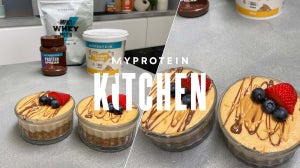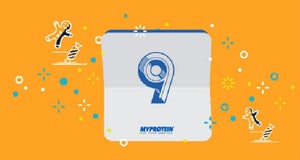
By Myprotein Writer
Alex Simpson
Does that milky protein shake make you feel bloated? For many people when they become diagnosed with lactose, its easy for them to eliminate dairy and move on with their lives.
However, those of us that are living in the fitness world know that there is a great amount of dependence on dairy for training. The most common food sources of dairy are cheese, milk and cream - but not a lot of people consider that it also means protein powder, protein bars and lots of other whey products.
No more protein shakes?
The main type of protein shake that is used in whey protein, which is a form of pure protein that originates from milk and is a byproduct in cheese making. This is a beloved way for bodybuilders, athletes and gym goers to get their protein due to it being quick and easy.
Another option is casein protein, but again this is a product of milk, therefore it's a huge no-go for those that are lactose intolerant.

Dairy-free protein powders
But there are other options! Brown rice protein, Pea protein, Hemp protein & Soy protein.
Take soy protein for example - it is less ‘bio-available’, therefore meaning that it is harder for the body to utilise for muscle building and in turn is lost as water.
Pea protein is more bio-available and contains all the amino acids that you will need – with less carbs (BONUS!). However, supplementation isn’t the only method of getting your protein in. While they are great and they save a lot of hassle and washing up in the kitchen, they shouldn’t be your sole source of protein.
There is still the beloved chicken, fish and dairy-free alternatives. This will enable you to build muscle without the need for whey. While it is important to be getting your protein in it doesn’t mean that you can neglect your calcium intake either. Calcium can be found in vegetables also – yes veg!
Are You Lactose Intolerant? |
Symptoms
? Wind
? Diarrhea
? Bloating
? Stomach cramps
? Nausea
The severity will all depend on the amount of lactose that you have consumed. While some can have a glass of milk and not get any symptoms, others can’t even handle it in their tea. One in five of the population are affected by the intolerance and affects all ages.
The Cause of Lactose Intolerance
Within dairy products there is the sugar lactose. Within the human body the enzyme lactase is used to break down the bonds of glucose and galactose that make up lactose.
However, in those that are lactose intolerant there aren’t enough of these enzymes to break it down. When it isn’t broken down it gets passed into the large intestine where bacteria ferment it into gas and acids (a.k.a farting).
Symptoms like wind, bloating and diarrhea are common after 30 mins – 2 hours of consumption.
| Lactose product | Swap |
| Milk | Soy, almond or coconut milk |
| Butter | Lactose-free margarine, coconut oil |
| Chocolate | Dairy-free Chocolate |
| Cheese | Soya cheese |
| Yoghurt | Soya yoghurt |
| Ice cream | Sorbet, dairy-free ice-cream |
Lactose-Free Recipes
Dairy free truffles | Serves 15
Ingredients
1 ½ Scoop Soy Protein Powder
20g Ground almonds
1 Tbsp soya milk (add more if needed)
Desiccated coconut (decoration)
Method1) Put all the ingredients into a bowl and mix.
2) Roll the balls into the coconut.
3) Lay a piece of baking sheet into onto a plate.
4) Roll 15 small balls from the mixture and place them on the paper.
5) Place in the freezer for 1 hour.
Dairy-Free Protein Pancakes
2 scoops Soy Protein Powder
300ml Almond milk
60g Instant oats
Baking powder
1 Whole egg
Non-stick spray
Method1) Mix all the ingredients together.
2) Spray the frying pan with non-stick cooking spray.
3) Cook until both slides are golden brown.
4) Top with any fruits you wish.
Take Home Message
Having to remove all dairy from your diet might have you worrying about hitting your protein intake and harming your gains. However, we have come a long way since the Stone Age!
1) Choices, N. (2016) Lactose intolerance. Available at: http://www.nhs.uk/conditions/lactose-intolerance/pages/introduction.aspx (Accessed: 7 July 2016).
2) Helen M. Barker BSc SRD MPH PGCE (2010) Advancing dietetics and clinical nutrition. Edited by Anne Payne and Helen M. Barker. Edinburgh: Elsevier Health Sciences.
3) Kleine-Tebbe, J., Waßmann-Otto, A. and Mönnikes, H. (2016) ‘[Food allergy and intolerance: Distinction, definitions and Delimitation]’, Bundesgesundheitsblatt, Gesundheitsforschung, Gesundheitsschutz., 59(6), pp. 705–22.
4) Mann, J. and Truswell, S. (eds.) (2012) Essentials of human nutrition. 4th edn. New York: Oxford University Press, USA.
5) Yuce, O., Kalayci, A., Comba, A., Eren, E. and Caltepe, G. (2016) ‘Lactose and fructose intolerance in Turkish children with chronic abdominal pain’, Indian pediatrics., 53(5), pp. 394–7.
Alpha Men Super VitaminsOur articles should be used for informational and educational purposes only and are not intended to be taken as medical advice. If you're concerned, consult a health professional before taking dietary supplements or introducing any major changes to your diet.








